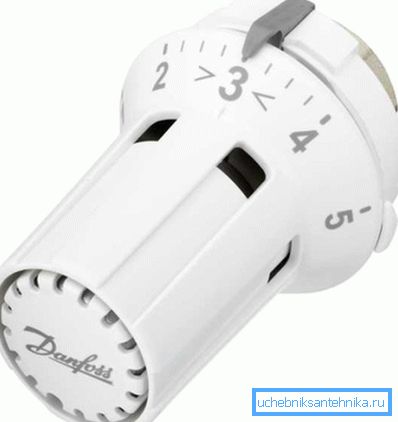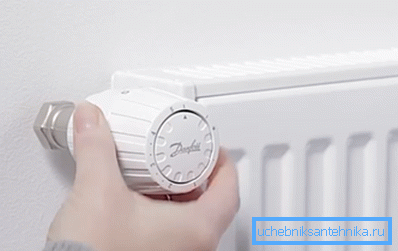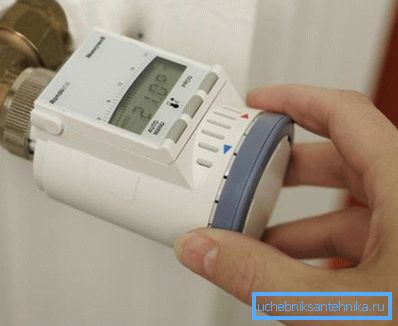Thermostatic kit for radiator. thermal heads. electronic
To begin with, there is a difference between the valves, for example, thermostatic valves for radiators, unlike control valves, are discrete, that is, they have only two main working positions - play-off, that is, either open or closed.
Such mechanisms do not regulate the flow rate on the supply pipe and, if circulation occurs, then it goes at full strength, or it does not exist at all, since the locking mechanism stops the flow of coolant until its temperature drops below the preset mode control knob.

Everything is very simple here, but we still understand this more specifically, and in addition, we will see the video in this article.
Thermal heads for heating devices

Note. For all types, the principle of operation of the thermostatic valve for the radiator is the same. With the help of a pen on which divisions are applied, you set the mode you need, for example, the number 3, which corresponds to 20? C.
In this case, if the air in the room (it passes through the grate surface of the handle) is heated to 21? C, then the rod presses on the valve and closes the circulation of water, and when the air is cooled to 19? C, then the stock opens and circulation resumes.
Mechanical devices

- First of all, it should be noted that a direct thermostatic valve for a radiator 1 2 with a solid substance (paraffin, stearin, ozokerite) has, as it were, a delayed reaction. That is, its heating or cooling occurs within 40 minutes, which can cause errors in a given air temperature in a given room, but it is considered the most reliable mechanism.
- In addition, the unit has a number of drawbacks, for example, after it is assembled by hand, a rather complicated setup procedure awaits you (explained in the instruction manual). In addition, factors such as drafts, sunlight, nearby household heating appliances, a refrigerator, as well as hot water supply and a heating circuit, affect its sensitivity.

Compared with devices on solid elements, liquid mechanisms react to a change in air temperature in a room much faster - they need about 25 minutes to do this, and the capacity of the bellows (thermostating element) here is somewhat less.
In this regard, a gas-type thermostatic radiator valve can be considered more reliable, besides the influence of extraneous factors such as drafts, the sun's rays, nearby household heating appliances, a refrigerator, as well as DHW and the heating circuit are less significant here. The error of such a device, depending on the parameters set by the manufacturer, is only 0.9-1.5? C.

The thermostatic head for gas-filled radiators is considered to be the most rapid in response, and, consequently, the most accurate when the parameters specified for a particular period of operation are observed.
The reason for this accuracy can be called the fact that the capsule with liquefied gas, which is here a thermostatic element, is located at a maximum distance from the walls of the device, therefore, changes in the temperature of the body, caused by the influence of extraneous factors, do not interfere. That is why, among the three types of mechanical units, the gas device is considered as the most accurate.
Benefits and customization

Such devices do not require maintenance and / or preventive maintenance, and for their installation there is no need to change the structure of the heating system circuit in any way. In addition, they are ergonomic - they have compact external parameters, are easy to operate and have a traditional color scheme, which allows to fit into almost any interior.
The thermostat allows you to evenly distribute the coolant along the contour of the heating system, therefore, optimizes the work of all equipment (boiler and pumps), and for the boiler there is no risk of working with peak loads.
In each individual room there is the possibility of installing a specific microclimate, and the adjustable temperature range is from +5? C to +300? C, with an accuracy of ± 1-20? C.

In order to make a start-up adjustment after the installation of the thermostatic head on the radiator, it is necessary to close all windows and doors in the room so as not to create an extraneous effect on changes in temperature. The appliance should not be covered with furniture, curtains or located near heating appliances (tiles, refrigerators).
After that, the valve should be fully opened, turning the head to the left until it stops, and the heating boiler must function normally (this way the radiator will work with maximum efficiency and the temperature in the room will quickly rise).
When the difference from the initial temperature rises by at least 5 ° C, the handle is turned all the way to the right, completely closing the valve - during this period you should wait for the optimal temperature in the room that suits you. After that, slowly turn the valve to the left until you hear the noise of the incoming water - leave it in this position.
Electronic thermostat

Thermostatic regulators of electronic type are of two types - with open and closed logic, that is, they are either subject to programming, or not, of course, regulators of the latter type are used for domestic consumption.
The main disadvantage of such devices is their high cost (the price, as you understand, affects quality) and dependence on the power source - a battery or a battery, but the accuracy here is unusually high.
Programmable devices are used for autonomous heating systems, as a central controller, which allows you to adjust the operation of the circulation pumps and the temperature of the coolant in the heating circuit. Through remote thermal sensors installed in each room, temperature information is transmitted to the center to correct the operation of the programmed instrument.
Conclusion
If you use a built-in thermostatic valve for steel radiators or aluminum sectional in autonomous heating, then in addition to the clearly defined microclimate in each room, you will receive significant savings in energy resources. You do not have to open the windows, because in your absence the house has become too hot and the saved heat will save your family budget.